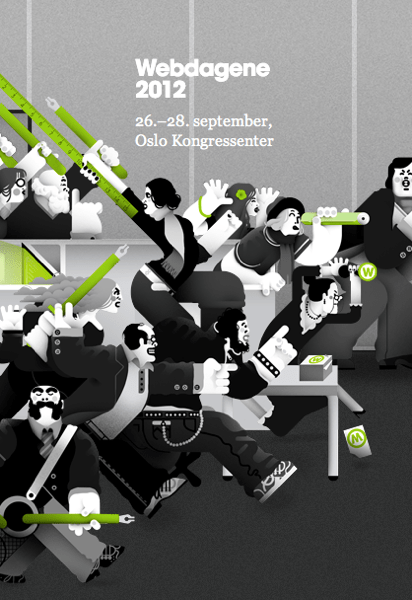
I am very pleased to announce that I will be giving a keynote talk on Service Design at Webdagene, billed as “Norway’s premier conference for web communicators with an expected 300 attendants in 2012.”
The conference is hosted and organized by Netlife Research, a leading Norwegian user experience consultancy and has had some pretty rocking speakers in the past, including Dan Roam, Jared Spool, Aarron Walter, Gerry McGovern, Stephen Anderson, Brian Sollis, and BJ Fogg. This year I’ll be in the company of Oliver Reichenstein, Des Traynor, Angela Morelli among others.
Designing for People vs. Screens
The theme of the conference is “Vs.” which of course sets up a slightly combative vibe, very much intended to get discussions going. My talk is “Service Design: Designing for People vs. Screens” or, in Norwegian, “Service design: Å designe for mennesker vs. for skjermer,” which sounds much cooler.
As someone with a background in interaction design who has moved into service design and who now teaches a lot of product design students, I find the conversations along the lines of “Isn’t service design just UX or IxD, etc.?” tend to be focused on screen-based experiences and this is a real point of difference in service design.
My talk will cover a some of the material and thinking in our Rosenfeld Media book, which may just be out around that time (if we hit our deadlines!). Here is the description I wrote in English (the Webdagene website is mainly in Norwegian):
Web and UX design has championed the user-experience over the past decade or so, but the domain in which they have been working is largely screen-based. Users and customers do not use these websites, applications and devices in a vacuum, but in the context of messy, complicated lives and service ecosystems. A well-built car-sharing website and smartphone app is only part of the challenge, for example. If the car is a pain to unlock in the rain or there are no designated parking spaces in the city, the service will suffer or fail.
We instantly recognise the design craft and appeal of an iPhone or a Porsche, but why are our experiences with telcos, insurance companies, airlines, etc. so poor? The answer is usually that they have just happened and have not been deliberately designed. Service design is the design for experiences that reach people through many different touch-points, and that happen over time, not just screens. It provides a powerful set of methods that help map out the entire service ecosystem and people’s journeys through it in order to design a coherent experience. Web and UX designers have an opportunity to expand on their existing skills to push upwards into designing with people instead of just for them.
But wait! There’s more. A Workshop with Lavrans and I.
I’m also really looking forward to running a workshop at the conference on the 26th called From UX to Service Design with one my co-authors and friend, live|work’s Lavrans Løvlie. Here’s the English description of what we’re planning:
The differences between service design and UX [or web design?] are best understood by trying to do it. This workshop introduces participants to the main principles and methods of service design through a practical, hands-on approach. Using a surprise theme as a starting point, participants will go out and do some quick and dirty insights research, bring their results back to the studio and map them out in a service blueprint. Having spotted the potential failures and opportunities, they will have to sketch up service propositions and touchpoints before presenting it all as a coherent experience by the end of the day. It will be fast-paced and jam-packed, but by the end participants will have designed a service or died trying.
I’m looking forward to it and hope to meet some of you there. I’ll report back on the rest, assuming I understood any of the Norwegian.

